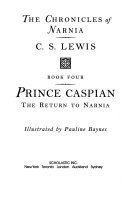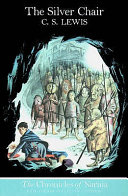
"The Chronicles of Narnia" Summary
By C.S. Lewis
fantasy | 767 pages | Published in 1956
Estimated read time: 7 min read
One Sentence Summary
Children stumble upon a magical wardrobe that leads them to a fantastical world called Narnia, where they must fight against an evil witch and aid a talking lion.
Table of Contents
Introduction
"The Chronicles of Narnia" is a beloved fantasy series written by C.S. Lewis. Composed of seven books, the series takes readers on a magical journey to the fictional world of Narnia. Filled with adventure, mythical creatures, and moral lessons, the books have captivated readers of all ages since their publication in the 1950s.
Brief Synopsis
The series begins in "The Lion, the Witch and the Wardrobe," where four siblings - Peter, Susan, Edmund, and Lucy - stumble upon a magical wardrobe that transports them to the enchanted land of Narnia. Narnia is a world inhabited by talking animals, mythical creatures, and ruled by the White Witch, who has plunged the land into eternal winter.
As the story progresses, the children become entangled in a battle between good and evil. With the help of the great lion Aslan, they must fulfill their destiny as the chosen ones to defeat the White Witch and restore peace to Narnia.
In subsequent books, the series explores different time periods and characters in Narnia's history. "Prince Caspian" follows the adventures of the Pevensie children as they aid Prince Caspian in his quest to reclaim his rightful throne. "The Voyage of the Dawn Treader" sees Lucy, Edmund, and their cousin Eustace embarking on a sea voyage to the edge of the world, encountering magical islands and facing their own personal challenges.
"The Silver Chair" introduces new characters, Eustace and Jill, who are tasked with finding Prince Rilian, the missing heir to the Narnian throne. "The Horse and His Boy" tells the story of Shasta, a young boy who escapes his life as a slave and embarks on a journey with a talking horse, Bree. "The Magician's Nephew" serves as a prequel, revealing the creation of Narnia and the origins of the iconic wardrobe. Finally, "The Last Battle" brings the series to a climactic conclusion as Narnia faces its ultimate battle between good and evil.
Main Events
| Book | Main Events |
|---|---|
| The Lion, the Witch and the Wardrobe | - The four Pevensie children discover the magical world of Narnia through a wardrobe. - They join forces with Aslan and the talking animals to overthrow the White Witch and free Narnia from her tyranny. |
| Prince Caspian | - The Pevensie children return to Narnia to aid Prince Caspian in his fight against his usurping uncle, King Miraz. - They lead the Narnians in battle and help restore Caspian to the throne. |
| The Voyage of the Dawn Treader | - Lucy, Edmund, and their cousin Eustace set sail on the ship Dawn Treader, embarking on a quest to find the seven lost Lords of Narnia. - They encounter magical islands and face various trials along the way. |
| The Silver Chair | - Eustace and Jill travel to Narnia to find the missing Prince Rilian and free him from the clutches of an evil witch. - With the help of the marsh-wiggle Puddleglum, they rescue Rilian and escape from the Underland. |
| The Horse and His Boy | - Shasta, a young boy, escapes his life as a slave and embarks on a journey with a talking horse, Bree. - They uncover a plot to conquer Narnia and ultimately play a crucial role in its defense. |
| The Magician's Nephew | - The origins of Narnia are revealed as Digory and Polly, two children from our world, stumble upon a portal to other worlds created by Digory's Uncle Andrew. - They witness the birth of Narnia and inadvertently unleash evil into the land. |
| The Last Battle | - Narnia faces its final battle between the forces of good and evil. - The Pevensie children, along with other familiar characters, play vital roles in the conflict, leading to the end of Narnia as they know it. |
Main Characters
- Peter Pevensie: The oldest of the Pevensie siblings, Peter is brave and responsible. He becomes the High King of Narnia and shows great leadership skills throughout the series.
- Susan Pevensie: The second-oldest sibling, Susan is practical and level-headed. She often serves as the voice of reason among her siblings.
- Edmund Pevensie: Initially portrayed as selfish and deceitful, Edmund undergoes a transformation and becomes a loyal and brave ally. He plays a significant role in the battle against the White Witch.
- Lucy Pevensie: The youngest of the siblings, Lucy is compassionate, curious, and possesses a deep faith in the magical world of Narnia. She is the first to discover the wardrobe's secret and has a special connection with Aslan.
- Aslan: The wise and powerful lion, Aslan is the true ruler of Narnia. He represents goodness, sacrifice, and redemption. Aslan guides and protects the children throughout their adventures.
- Prince Caspian: A young Telmarine prince, Caspian becomes a central character in the series. He is courageous, resourceful, and strives to restore Narnia to its former glory.
- Eustace Scrubb: Introduced in "The Voyage of the Dawn Treader," Eustace initially embodies selfishness and cowardice. However, he undergoes a transformation and learns valuable lessons about humility and courage.
Themes and Insights
"The Chronicles of Narnia" explores several themes that resonate with readers of all ages:
- Good versus Evil: The series delves into the eternal battle between good and evil, emphasizing the importance of making moral choices and standing up for what is right.
- Faith and Redemption: The character of Aslan embodies themes of faith, redemption, and self-sacrifice. His actions and teachings inspire characters to find hope and believe in something greater than themselves.
- Coming of Age: The Pevensie children, along with other characters, experience personal growth and maturity throughout their journeys in Narnia. The series explores the challenges and lessons that come with growing up.
- Loyalty and Friendship: The bonds of loyalty and friendship are tested and celebrated in the series. Characters are often required to make sacrifices for one another and learn the value of true companionship.
- Nature and Creation: The natural world and its relationship with humans are explored in the series. Narnia serves as a reminder of the magic and beauty found in nature and the importance of preserving it.
Reader's Takeaway
"The Chronicles of Narnia" is a timeless series that transports readers to a world of magic, adventure, and moral teachings. It captivates with its engaging plotlines, lovable characters, and profound themes. The books provide an opportunity for readers to explore their own beliefs, reflect on the power of faith, and appreciate the beauty of the natural world. Whether read as a child or an adult, "The Chronicles of Narnia" is a literary journey that leaves a lasting impression.
Conclusion
C.S. Lewis's "The Chronicles of Narnia" is a beloved fantasy series that has enchanted readers for generations. Through its captivating plotlines, intriguing characters, and profound themes, the series takes readers on a magical adventure to the land of Narnia. As readers journey alongside the Pevensie children and other characters, they are immersed in a world where good battles evil, faith is tested, and moral lessons are learned. "The Chronicles of Narnia" remains a timeless classic that continues to inspire readers of all ages to embrace their own inner courage and explore the power of imagination.
The Chronicles of Narnia FAQ
What is 'The Chronicles of Narnia' about?
How many books are in 'The Chronicles of Narnia' series?
In what order should I read 'The Chronicles of Narnia'?
What age group is 'The Chronicles of Narnia' suitable for?
Is 'The Chronicles of Narnia' a religious book?
Are the movies based on 'The Chronicles of Narnia' faithful to the books?
Are 'The Chronicles of Narnia' standalone books or should they be read in order?
Is 'The Chronicles of Narnia' suitable for bedtime stories?
Are there any spin-off books or companion novels to 'The Chronicles of Narnia'?
What makes 'The Chronicles of Narnia' a classic series?




